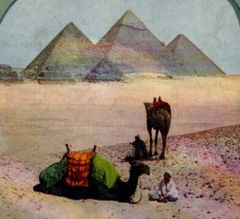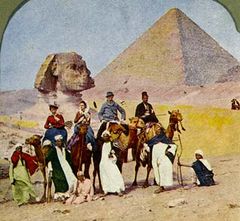Giza pyramid complex
2007 Schools Wikipedia Selection. Related subjects: Archaeology; Architecture
The Giza Necropolis (coordinates ) stands on the Giza Plateau, on the outskirts of Cairo, Egypt. This complex of ancient monuments is located some eight kilometres (5 mi) inland into the desert from the old town of Giza on the Nile, some 20 kilometres (12.5 mi) southwest of Cairo city centre.
Great Pyramids of Giza
This Ancient Egyptian necropolis consists of the Pyramid of Khufu (also known as the Great Pyramid and the Pyramid of Cheops; coordinates ), the somewhat smaller Pyramid of Khafre (or Chephren; coordinates ), and the relatively modest-size Pyramid of Menkaure (or Mykerinus; coordinates ), along with a number of smaller satellite edifices, known as "queens" pyramids, causeways and valley pyramids, and most noticeably the Great Sphinx. Associated with these royal monuments are the tombs of high officials and much later burials and monuments (from the New Kingdom onwards), signifying the reverence to those buried in the necropolis.
Of the three, only Khafre's pyramid retains part of its original polished limestone casing, towards its apex. It is interesting to note that this pyramid appears larger than the adjacent Khufu pyramid by virtue of its more elevated location, and the steeper angle of inclination of its construction – it is, in fact, smaller in both height and volume.
The most active phase of construction here was in the 25th century BC.
The ancient remains of the Giza necropolis have attracted visitors and tourists since classical antiquity, when these Old Kingdom monuments were already over 2,000 years old. It was popularised in Hellenistic times when the Great Pyramid was listed by Antipater of Sidon as one of the Seven Wonders of the World. Today it is the only one of the ancient Wonders still in existence.
Due largely to 19th-century images, the pyramids of Giza are generally thought of by foreigners as lying in a remote, desert location, even though they are located in what is now part of the most populated city in Africa . Consequently, urban development reaches right up to the perimeter of the antiquities site, to the extent that in the 1990s, Pizza Hut and KFC restaurants opened across the road .
The ancient sites in the Memphis area, including those at Giza, together with those at Saqqara, Dahshur, Abu Ruwaysh, and Abusir, were collectively declared a World Heritage Site in 1979 .
Major components of the Pyramids
- Pyramid of Khufu ("broken Pyramid")
- Pyramid of Khafre
- Pyramid of Menkaure
- Great Sphinx
- Khufu ship
Alternative theories
Orion Correlation
Although hypotheses put forward by Robert Bauval are universally regarded by mainstream archaeologists (Lehner 1997) and Egyptologists as a form of pseudoscience, Robert Bauval and Adrian Gilbert (1994) proposed that the three main pyramids at Giza form a pattern on the ground that is virtually identical to that of the three belt stars of the Orion constellation. Using computer software, they wound back the Earth's skies to ancient times, and witnessed a 'locking-in' of the mirror image between the pyramids and the stars at the same time as Orion reached a turning point at the bottom of its precessional shift up and down the meridian. This conjunction, they claimed, was exact, and it occurred precisely at the date 10,450 BC



